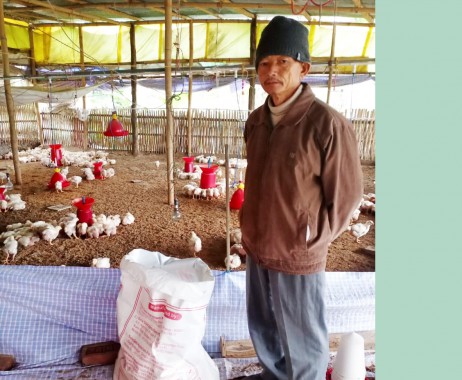




















Monday, Nov 30, 2020 08:15 [IST]
Last Update: Monday, Nov 30, 2020 02:52 [IST]
We are seeing a 30% growth monthly even after lockdown ended: Rewaj Chettri
SE LONG READ
GANGTOK,: As the saying goes, adversity brings out the best among us. At the peak of lockdown in April, when poultry business was a Covid casualty, a young Sikkimese entrepreneur was passionately motivating the poultry farmers of Sikkim to get back into business.
Rewaj Chettri felt that the lockdown circumstances, though uncertain and miserable, could actually work in favour of the poultry farmers as the home delivery market was available with the major existing players out of action. Only some infrastructural development, marketing strategies and courage were required for reaching out to the consumers during the pandemic lockdown period.
It was in April end when he did a Carpe Diem meeting with the poultry farmers of Sadam, Turuk and Paiyong, south district and shared his ideas for a contract poultry farming collaboration, recalls the 26-year-old entrepreneur, who hails from Turuk. The poultry farmers of Sadam-Turuk-Paiyong poultry farmers’ cooperative society – an initiative of Rewaj’s late father Taraman Chettri – corresponded with his presentation and reached an agreement.
Sikkim Farms was thus born with an investment of around Rs. 70 lakh with Rs. 22 lakh coming from the poultry farmers.
Eleven of them contributed Rs. 2 lakh each for the infrastructural requirement of Sikkim Farms. The society, with around 500 poultry farmers, supplies around 80% of total poultry requirement of Sikkim. Rewaj Chettri, through Sikkim Farms, has to market and supply 5% of their poultry meat which comes to around 1500 kg daily.
The three outlets and processing unit are owned by the cooperative society. Sikkim Farms provides the platform, manpower and distribution services.
On July 21, a day before the second lockdown, the poultry dressing unit machines reached Sikkim and was installed at the State-owned abattoir in Khani Khola near Majhitar, Rangpo. Poultry sourced from the cooperative society were processed at Khani Khola and then taken to the doorsteps of the customers in two-wheelers.
Sikkim Farms was operational.
LOCKDOWN LIFT
For around six months of 2020, the Indian poultry industry was at near death bed due to Covid-19 pandemic and lockdown. Social media rumours linking consumption of poultry to coronavirus hastened the meltdown of poultry sector. It was only in the past two months, following total unlock, that poultry products are finding space in home kitchens and restaurants.
From March to early September, poultry farmers in India were suffering colossal losses with many of them giving up this livelihood totally. April and May were the worst months with the total lockdown bringing the nation to a standstill.
A ray of hope amidst the general gloom emerged when home delivery of essential commodities including poultry meat was allowed through two-wheelers during the staggered lockdown period. It was the catalyst which brought the fresh chicken legs and wings from Sikkim Farms at your homes when venturing out was not possible.
Gangtok, the State capital with an around 1.5 lakh population, consumes around 8,000 kg of poultry meat every usual day. Sikkim Farms, which officially started from July 21 does a business of 800 kg of poultry daily for Gangtok.
It was from July end till September when certain lockdown restrictions were still in place that Sikkim Farms made its presence felt among the poultry meat consumers of Sikkim. Vacuum, visibility and viability are the elixirs for any business and available through the lockdown which, importantly, ruled out other traditional competitors.
“If there was no lockdown, Sikkim Farms would not have been there. People would have never tried our product. In today’s time, it is impossible to launch a new brand. Lockdown provided enormous visibility to us which has come down now (unlock) but it gave me a boost. There were no other players and it was easier then. People wanted meat at their homes,” said Rewaj.
Fingers were burnt in the initial months.
“We had never handled fresh produce and so it was a first for us. Most of the meat used to get spoiled…we had to discard around 600 kg to 700 kg of spoiled meat in a month. It was our focus that the best quality meat reaches our customer,” said Rewaj.
It was only in October that Sikkim Farms managed to contain the monthly losses to a respectable Rs. 81,000 after getting some experience and correcting the flaws. The business unit suffered around Rs. 5 lakh loss monthly in the initial period.
November is the month when Sikkim Farms is ‘breaking even’ where total revenue equals total expenses.
NEW CUSTOMERS IN UNLOCK
By the time the national unlock started and gradually restrictions were relaxed in the State, Sikkim Farms had created a customer base.
“Right now we have around 1,500 to 2,000 regular customers within Gangtok who buy our meat each week. Home delivery services went on a decline after the lockdown started easing out. At the same time, our customers who run hotels and restaurants are increasing. We are seeing a 30% growth monthly even after the lockdown ended,” said Rewaj.
To get restaurants and hotels as customers, it is all about a good price and consistency, shares Rewaj.
“There are lots of people who purchase meat from us because the meat is fresh. But it is a whole different game with restaurants as they give priority to pricing. They are open for business if we are able to give the product at a lesser rate than the other dealer. We also have a policy that Sikkim Farms is open every day even during festivals. We are trying to maintain consistency and we are competitive in pricing also and our products being fresh are way better than frozen meat,” said Rewaj.
Sikkim Farms received an additional boost in September after bagging a bagging a six-month order to supply around 30,000 kg of poultry to ITBP camps spread in different locations of Sikkim.
November is the month when Sikkim Farms finally breaks even whereby it can cover its operating costs. We will break even in November and our operating costs are secured from this month, said Rewaj.
Sikkim Farms employ around 45 people including four two-wheeler delivery persons (three in Gangtok and one in Majhitar) and a delivery van operator.
SECURITY FOR POULTRY FARMERS
Every morning, the cooperative society collects the chickens from the farmers and sends the collection to the Khani Khola processing plant by evening. The next morning from 2 am onwards, the dressing and processing of the chickens start. The processed chicken meat is then loaded in the delivery van and by 9 am, the delivery starts at different locations in Gangtok, Singtam, Majhitar, Rangpo and Ranipool.
Rewaj defines Sikkim Farms as a business partnership between an entrepreneur and farmers with the latter secured with a minimum price support.
“Sikkim Farms have signed a MoU with the farmers giving them minimum price support. Earlier it was like gambling for the farmers with rate high sometimes and rate low sometimes. Once we stepped in, we have kept a fixed procurement rate with them. The farmers now have a sense of security and do not have to worry where and how to sell their produce,” said Rewaj.
Confidence has reached to a level where the farmers are now asking Sikkim Farms to go beyond the 5% procurement quantity.
“Yes, pressure is there from the farmers that we need to get this percentage up slowly. We are planning to come up with a frozen unit because there is a requirement of frozen poultry meat for the Army and Army is the biggest customer in Sikkim. We are working on this future plan and if we are successful in getting the Army contract, our procurement from the farmers will shoot up to 60%,” said Rewaj.
Rewaj drew inspiration to start Sikkim Farms from his late father Taraman Chettri who initiated contract farming in the late 90s. He was exposed to poultry farming early on and the pain attached with it.
“Due to the sudden demise of my father, it was my responsibility to make the poultry farming sector a bit better. I could have done it solo but getting the farmers together and working in a collective manner was my priority.”
Rewaj could relate to poultry farming and poultry farmers emotionally.
“I have seen my father doing it. I had also reared some chickens while as a student in Sadam and so I knew the pain. Growing a produce is one thing but selling at that time came to beg someone to take your produce,” said Rewaj.
